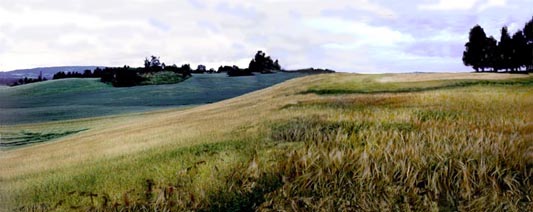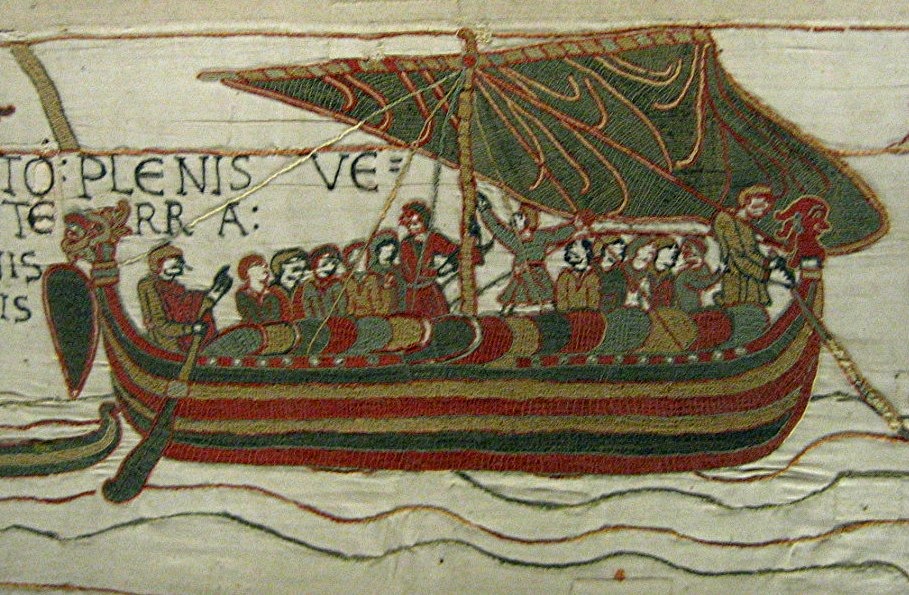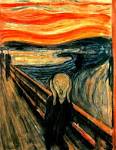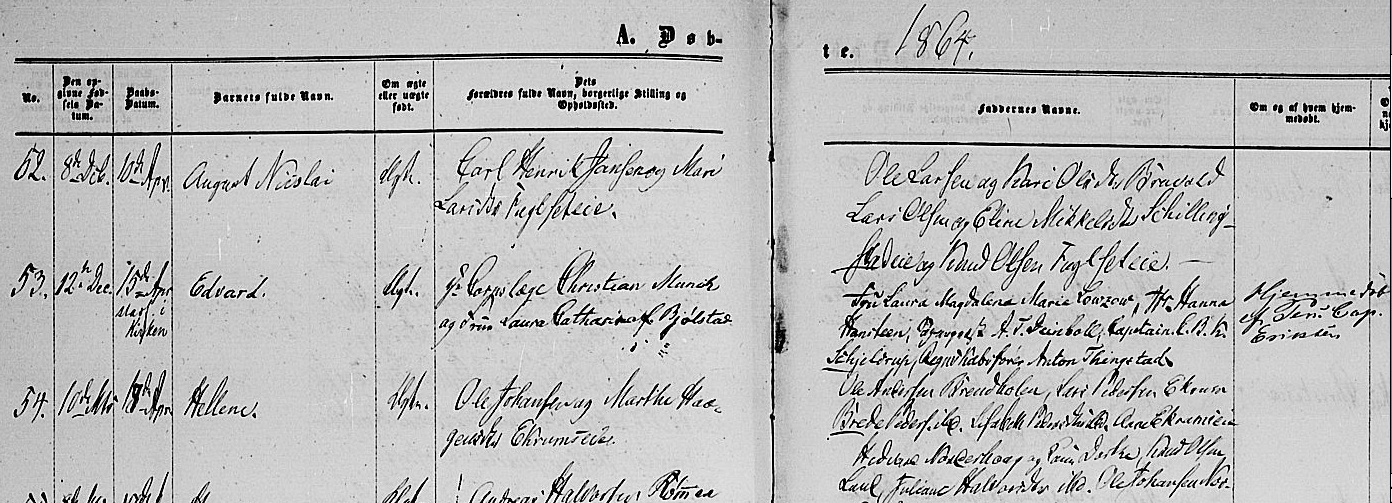

The Norwegians that occupied this part of south-eastern Norway
were generally farmers of small plots of vegetables and grains,
such as, oats, barley, and rye. Potatoes became the dominate
crop during the mid 1800's. The latitude is about 70 kilometers
north of Oslo, which is about the same as Anchorage, Alaska.
It's a rolling landscape with areas of forest somewhat similar to
Minnesota where many Scandinavians later settled. Even the name
"Loten" is derived from and an Old Norse word Lautin which means "old
farm". The old farm may be the one that is now call Prestgarden or "vicarage"
where the first church was built. Spelling has varied over
the years in various documents from 1500 "Leuten",
"Leuthen", "Lautin", from 1838 "Løiten" or from 1918
"Løten". [Wikipedia 2013] Hedemark has an ancient reputation
as a major agricultural area of Norway. The tribe that
lived in this region was the Heidnir that was ruled by Halfdan
Whiteleg in ancient days, perhaps before 500 ad. [Jones 81,
25, 84]
This region also has a long history of logging and a cross-road
of trade. Small plots of land were developed as farm plots
of from 5 to 15 acres. They also raised sheep, cattle,
chickens, and pigs. Some nutrition was also derived from
fishing from the nearby streams using line as well as nets.
Crops, animals, and humans were all dependent on a short growing
season, good weather and good luck. Farming was a skill that
was passed on from generation to generation and the primary
activity of most of the Norwegians who came to the United
States. If the farms were successful so were the number of
surviving children. Through to the mid-1800's much of
the population were intinerant farm workers who could own no land
and land ownership that did exist usually went to the eldest
son. During the 9c the serfs and younger men, in particular,
had to find some other means of prospering and often saw joining
raiding parties as an adventure as well as an opportunity to gain
wealth, position and land.[Jones 211-212] In the 19c
immigrating was seen as a more appropriate method.
According to most researchers this region of Norway has the
highest representation of I1 (Y-DNA)- or Haplogroup I-M253 DNA of
all of Europe and is the oldest haplogroup in Europe meaning that
it may have been from a people that came into Europe shortly after
the last Ice Age from 4,000 to 5,000 years ago, following herds
north from the Mediterranean and developed in isolation in
Scandinavia, in particular northern Denmark, until trade and
plunder spread the DNA throughout western Europe. The areas where
the Vikings settled still maintain high ratios of I1 such as
Finland, Sweden, Iceland, Yorkshire, Dublin, and Scotland.
[Eupedia, Haplogroup I1] This is the haplogroup that Bryan Sykes
in the Seven Daughters of Eve, identifies
as Ursula from his research of the female mitochondrial DNA.
[Sykes, Daughters]
Since farming and surviving was largely
dependent on the climate and where Winter was considered "a time
of slumbering death". It was a natural extension to worship
animistic gods that may control those elements. Sites were
set up for gatherings around the solstice and other important
seasonal time periods. Many of the Scandinavian traditions were
well established before Christianity and have become part of the
present Christmas celebrations. The Xmas Tree, Yule log,
Nordic Midwinter feast, the Xmas wreath was set afire and rolled
down hill to bring the sun, and Old Man Winter (Odin) became the
English Father Christmas. The religion of Odin, god of wisdom, war and
poetry, Frigg (his wife)
goddess of home, Freyr, god of fertility, Sol,
goddess of the sun, Jøro,
goddess of the earth and Thor
(son of Odin) the god of thunder, and many more were gradually
supplanted by Christianity brought in mostly by English captives.
Some of these captives may have included monks from the
monasteries which they pillaged. Continuous and regular
raiding was carried out from about 800 ad in Scotland, Britain and
Ireland. The Danes were known as Ó Dubhghaill, or
"descendent of dark or new foreigner" who settled in the Wexford
area may actually have been Cimbri or Charudes tribes from the
Jutland and Dani from Skandi. The Cimbri defeated the Romans army
in several battles about 100 AD while they forayed across Europe
sometimes with their Saxon and Teutones neighbors. Women were used
as seers and priestess over human sacrifices during the Roman era
and often went on raiding expeditions with the men. [Jones 26]

A Viking ship participating in the raid on Normandy in 1064-66 in
the Battle of Hastings
"Bayeux Tapestry" c1070, photo Wikipedia Commons.
Viking settlements in Britain, Scotland, Ireland and Normandy
were regional trade and raiding centers. York had many
Scandinavian and Danish kings from the early 876 to the late 954.
Viking Kings ruled Dublin from 852 to 1111. The Danish invaders
were known in Ireland as Ó Dubhghaill (dark foreigner).
After establishing colonies it eventually changes to become the
family names of Doyle and MacDougall. The "fair foreigner" Fionnghoill
of Ireland was used to describe the Vikings or Norwegian
invaders perhaps of the Bohulan tribe into Ireland a few hundred
years later. Fionnghoill was later associated with the
invading Scots who also had a Viking heritage.
Undoubtedly there was much other contact with the British
Isles. The Danes had already made more permanent residences
in Ireland by 850. They were used as mercenary warriors for
Irish chiefs. They in turn had to fight against the other
later invader Vikings and became well integrated into Irish social
structure. [Jones 26] DNA studies of the British Isles by James
Sykes have proved pretty conclusively that the Vikings actually
took their women with them as settlers to most of the
locations. Trade and farming seems to have been the main
goals of these immigrants while they probably let the stories and
labels as marauders persist to strike fear into any potential
opposition. [Sykes]
The Catholic monks gave the northern tribes a new story of
creation and different rules of conduct that had to be married to
their already well formed beliefs. Christianity became the
official religion under King Hakon the Good about 930[DuBois 175].
Some of the indigenous beliefs had cruel consequences. The
Norse meted out punishment based on at least a 12 men jury at a
"thing". This did not always, as today, result in justice which, I
might add, was not to be out done by Christianity. Scandinavia
didn't adopt Christianity easily. Charlemagne battled Godfred to
the Elder river in Jutland but was not able to conquer them. His
purpose was to convert the heathen north. The several
battles and the death of Charlemagne in 814 created a stalemate
between the north and the Franks. Christianity made more
conversions by diplomacy and concessions than by battles. It
became the state religion of Norway about 1024. Even still it was
not accepted by all the population. About 1030 the Norwegian
chieftain Olaf the Stout Harldsson/Olav Haraldsson, King of
Norway, is baptized at Rouen. He battles in England and fights a
loosing battle to convert Norway. He eventually is recognized
after his death as St Olav, the patron saint of Norway. He is
buried in the Nidaros
National Cathedral. Paganism, superstition and ignorance
were still holding sway over certain populations. Olaf becomes one
of the most popular male names in Norway.

The Løten Church pictured here was built in 1200
and is a registered landmark for architecture in Norway. It was
probably built on the site of an earlier pagan stave
building. Very early church buildings were often timbers
planted in the ground with a roof attached. These
early stave structures rotted rather easily in the moist
climate. Of the perhaps 1000 stave churches only 28 still
exist. Eventually a stone and timber Gothic design created a
more permanent structure that could withstand the element by
elevating the timber on large stone foundations. This type
of design was spread throughout Norway. Of the 270 stone
churches built only 160 remain today. [kirkesok.no]
Lutheranism became the official religion about 1530 and took over
most of the Catholic churches. During the Reformation the
protestants appropriated the former Catholic churches, white
washing the interiors to eliminate the frequently decorated walls
of distracting or figurative images. Prayers were to be
performed with concentration, obedience and austerity.
Between 1593 and 1692 there were 140 witch trial in Vardø,
Finmark. They convicted 91 which were burned at the
stake. About one third of these were Sami, reindeer herding
people, who seemed different from other Norwegians.
[Strochlic] As late as 1621 witchcraft trials were performed in
Bergen. Suspected women were hauled in for causing ship
wrecks, plagues, deaths of animals but also for being able to say
more than the Lord's Prayer because they were educated.
[Gjerset 175] During the 1600's Løten was considered a
center of witchcraft. There were 15 cases of witchcraft
prosecuted here between 1600 and 1625 of witches, demons and
Gitola. In this period of Norway as a whole there were 143
people found guilty of "trolldom" or witch craft that ended with
them being burned at the stake. [Nedrobo]
Norway had, according Hubert H. Lamb's Climate, History and the Modern World, many years of vastly difficult weather conditions between 1690 and 1710. The Little Ice Age froze rivers, the Baltic sea, and created glaciers in Norway that forced the abandonment of farms. These kinds of conditions were repeated again in "1837-38 and was such an extreme winter in Scandinavia that there was ice all the way from Skagen (the north tip of Denmark) to the southernmost point of Norway and round along the southwest coast of Norway as far out to sea as the eye could see. (In March 1838 the ice on this Atlantic coast was drifting back towards the south again.)" These cold winters were also accompanied by wet summers. The wheat crops failed due to the wetness and the potato took the place as the dominate crop. Constant planting and the potato blight (Phytophthora infestans), that was believed to be imported to Europe from America in 1845 probably aboard a returning passenger ship, grows abundantly with a constant 10 C and 90% humidity. "We read in a farm diary from as far away as Jaeren in southwest Norway that in 1846 the alternations of rain and sun, always with warmth, ripened the corn quickly and it was safely got in by 29 August, but the 'the potatoes rotted again.' In Ireland, where the potato was the staple crop on multitudes of small farms, 80 per cent of them under 6 hectares (15 acres) and many only a fifth of that size, the effect was devastating." [Lamb p. 231- 232]
During the 1800's potatoes were a dominate crop and became a most
important ingredient in Norwegian recipes such as "lefsa", a
potato pancake. Some Norwegian lore states that lefsa was a
creation of the Vikings. It attributes its discovery to a Viking
boatman(c8-10C) that couldn't eat another potato and threw it into
the fireplace where it stuck to become the future dish.
Since the potato was not imported from the New World until
Christopher Columbus in 1492, the story could not be other than
cultural lore. Certainly lefsa as a bread was probably made
dominately with wheat and perhaps with variations using turnips,
and other starchy root crops. The potato was not affected by the
latitude and rough growing conditions of Norway. A side affect of
eating potatoes was the diminishing of the incidence of scurvy
among seafarers and populations in the Highlands of Scotland and
elsewhere. [Carpenter 101] Very much like Ireland, the wide
popularity of the potato caused a population explosion and forced
a dependence on the continuation of the planting of
potatoes. From 1810 to 1847 the population almost
doubled. By the mid- 1800's Norway experienced their own
"potato famine" caused by successive failures of this most
important crop. The potato blight responsible for the Irish
Potato Famine caused in Norway many of the same hardships and
forced the breakup of large families and emigration of many to
the United States. [Lamb 225]
In Scotland with a similar latitude and proximity to Norway also
had corresponding crops and weather. Scotland was similarly
afflicted. In 1846 the Highlands potato crops were blighted
and the following winter it was particularly cold and snowy.
Between 1846 to 1852 1.7 million people emigrated from
Scotland. The most well known famine from the potato blight
was in Ireland where approximately 1,000,000 people died and
caused the emigration of 1.7 to 2 million. [Lamb 231]
[Wikipedia.com]
The Løten/Hedemarken area of southern Norway had other issues. Land controlled by the church and the royalty created political intrigue and helped cause poverty even with good weather. In the 1600's the King of Norway and Denmark had sold the churches in Løten as a way of financing a war. The peasants were still expected to pay the tithe to the new owners who had to split with the tithe with the King. Failure to pay the tithe could risk imprisonment. This led to a minor rebellion with the leaders of the revolt thrown into prison and some into slavery. Although agriculturally bountiful, land was still controlled by a feudalistic land based system that limited economic prosperity of the peasants who raised large families. Even the nobility had problems. "Norway had just gone through the Reformation in 1536 and the Norwegian Nobility had been diminished by half the numbers and political power. It was also lacking in education for administrative ability. To ensure Danish control the King of Denmark sent Danish noblemen to occupy the needed rolls and urged them to marry landless women or women who lack noble birth while assuming control of the estates. By this technique the Norwegian nobility line of inheritance was broken and bred out of existence." After 1536 only 15 percent of Norwegian land was in noble possession" but marriages to landless women further diminished the previous nobility. [wikipedia.org/wiki/Aristocracy_of_Norway]
See
my story of the Arild
Hake family.
By the 1624 the prohibition of importing German beer created an
opportunity for local farmers who found they could make a pretty
constant living by brewing beer, and later in Løten, distilling
from either grains or potatoes an herb and spice laced liquor
called "akvavit" for which they became renowned. It has almost
become a national drink also known as Aquavit. The Atlungstad Brenneri on the
Atlungstad farm became the
major manufacturer of Aquavit through to the 1800's.
[wikipedia.com]
Even if they had some rights to land, the youngest sons were cut
out any inheritance to land and had to gain other skills for
support and the daughters were married off with hope of
prosperity. Younger family members were the normal target for
immigrant recruiters. One author, Anderson on Norwegian
Immigration, 147, summarized by Babcock, "Times were hard
money was scarce and its value fluctuating. The crops were
often short, the prices of grain were high, and the demand for the
labor of the peasants was weak; the economic conditions of the
lower classes, especially in the rural districts - much the
greater part of the country - were growing worse rather than
better. Even the oldest son, who was heir to his father's
homestead, was likely to find himself possessed of a debt-burdened
estate and with the necessity of providing for the mother and
numerous younger children. The younger sons, being still
worse off, were forced to try their hands at various occupations
to earn a bare living." [Babcock 30-31]
Early immigrants such as Gjert G. Hovland, wrote back to Norway
in 1835 and their letters were copied and distributed widely
during 1830 to 1840. He gave "high praise of American legislation,
equality, and liberty, contrasting it with the extortion of the
Norwegian official aristocracy." [Babcock 30] Immigrants listened
to these ideals of prosperity and agents established head quarters
in the major cities of Norway and Sweden to recruit workers for
the railroad and other business. Even the states of
Wisconsin and Minnesota had set up permanent and roving agents to
promote their particular territory to new immigrants. Cleng
Peerson, a Norwegian adventurer, was first hired by the
Quakers of Norway to find places for them to work and find cheap
land in New York. He later expanded his enlistment and
destinations to include Indiana, Illinois, Wisconsin, Minnesota
and Texas. Cleng Peerson final
resting place is in the last community he established in Cranfills Gap, Texas where he
died in 1865. He is buried here in the Norse
cemetery.
Babock reported:

Although I have had a special affinity for Edvard Munch, I found
out that I have a closer connection than I thought. Edvard's
father was a regimental doctor who worked on an emigrant ship to
New York about 1860. He married Laura Cathrine
Bjolstad in 1861 and lived in Løten. Of this small
community of only 7500 in modern time, Edward Munch was born in
Løten in Dec. 1863 on a farm called Engelhaugen (Ostre Englaug gard -
EC).
1863, Dec 12 - Edvard Munch was born to Christian Munch and
Laura Catharine of Bjørnstad. Laura was raised locally and
was artistic herself. The following parish record shows that
Edvard was baptized on April 15, 1864.

There is a farm named Engelhoug on the 1862 map that is just a
kilometer or so from where my grandmother, Olianna Maria was born
here in 1858 on the Aadalen/Oudalen
farm. This is only 5 years before Edvard was born in the
same town. Edvard Munch (12 Dec 1863-1944) lived
mostly in Christiana, now Oslo. There is not room here to
give his complete history. There is a farm used as a museum of his
early work that has tours - Munch Center at
Klevfos in Løten. It is an old paper mill just up the street
from the Aadalen/Oudalen
farm. His family moved to Christiana in 1864, as Oslo was
known then. His mother dies in 1868 of tuberculosis when he
was only five. He was raised in Oslo and as an adult lived a
bohemian life style until his own depressive mind took control
with the help of alcoholism and other lifestyle activities. He
makes several visits to Løten and considers this a place in which
can find peace and friendship. He writes, "My mother came of good
strong farming stock, but her natural strength was gradually eaten
away by the worm of consumption. My father, as you already
know, came from a literary family: he had the makings of a genius,
but he was also tainted with a tendency towards degeneracy. I
arrived in the world on the point of death and my parents had to
have me christened at home as quickly as possible. At the time my
mother was carrying within her the germ of the tuberculosis that
six years later was to deprive five children of their
mother. Sickness and insanity and death were the black
angels that hovered over my cradle and have since followed me
throughout my life. ..... " [Stang 31] Another interesting
fact is that "The Scream" was painted from Ekeberg Hill
over-looking Oslo. Ekeberg is an name associated with royalty and
thus denotes several geographic locations but comes from the word
for a type of Oak tree, somewhat rare in Norway. The Ekeberg Park
in Oslo, now preserved for the public, was previously a royal
hunting area. It has been opened in Sept. 2013 as a sculpture
garden dedicated as "an homage to women" by Christian Ringness
with $50m in donations. Ekeberg Park.
|
This partial map of Løten
and Romedal area of Hedmark comes from 1862
several farms on which Even and Marianne lived are marked in red. [Norgeskart historical map - Amtskart] |
Partial map of Hedmark
centered on Løten with farm names.
Even was born on the Tomteri farm in the
upper left corner and named himself after the Røne farm.
There may have been as many as three Røne/Rohne/Rønne
farms at one time.
The larger size at 300 dpi - 1.7 mgI don't have any information on where this came from or when it was created but I believe that it was created about 1900 but certainly after 1862 when the railroad was built. |
Farm names and associated families. I have included here as many
farm histories as I can find. Most are in Stange parish, some that
are in Romedal I have not been able to find a source for histories
without going to Salt Lake City. These are sometimes
stand-alone pages other times included in the family
information. I'm trying to link the families together
through these farms with some families connected to several farms
over several generations.
see the selected list of farm names with links here.
Stange farms, Hedmark
Romedal farms, Hedmark
Oppland farms
Of many people born here, including my own grandfather Evan Rohne (22 Sep 1848-1901).
Unlike many Scandinavians, my own relatives came to Texas with the
sanction and approval of the King of Norway and Denmark. A
sizable acreage was offered to emigrating Scandinavians for
settlement. The central Texas area to which they came has
low rolling hills covered with small cedar trees and limestone
cliffs. It is a much hotter climate here. My own relatives
became successful farmers of primarily wheat, corn and cotton but
also raised cattle and sheep. According to Odd Magnar
Syversen in his article in Lautin
on a letter from America. There was a great number of
residents from Løten who left the region between
1860 and 1880 until there was a community of 161 persons forming
their own colony (Løtensokninger)
in
Bosque,
with
the
"capital"
being
in
Clifton,
Texas
[Syversen]
Kleng
Peerson
is buried at the Norse Church near Cranfills Gap, Texas.
Source:
Babcock,
Charles Kendric. The
Scandinavian Element in the United States, University of
Illinois Studies in the Social Sciences,
Vol.
III.
No.
3
Sept.
1914, Pub. by the University of Illinois, Urbana, 1914
Carpenter,
Kenneth J. The History of
Scurvy and Vitamin C., The Cambridge University Press.
Cambridge, UK 1986
DuBois, Thomas A. Nordic
Religions in the Viking Age. University of Penn. Press.
Philadelphia. PA 1999
Ekeberg Park, Oslo, Norway
website. http://www.ekebergparken.com/en/
Eupedia,
European Travel and history.
http://www.eupedia.com/europe/Haplogroup_I1_Y-DNA.shtml
Gjerset,
Knut. History of the Norwegian
People, Vol. 2 Macmillian Co., Norway 1915
Haywood,
John. The Penguin Historical
Atlas of the Vikings. Penguin Books, Ltd. , 80 Strand ,
London, England, 1995
Jones,
Gwyn. A History of the Vikings.
revise ed. 1907, Oxford University Press. London 1984
Kirkesok
Kirkebkyggdatabasen - http://www.kirkesok.no
Lamb, Hubert H. Climate, History and the Modern
World. Routledge, 2nd ed. 1982
Nedrobo, Yngve.
"To the Fire and Fire" - the witches and demons in Løten 1600-1625".
Lautin, 1986
Norgeskart
(Norwegian Maps - historical Amtskart of Hedmark, Løten)
http://www.norgeskart.no/adaptive2/default.aspx?gui=1&lang=1
Stang,
Ragna. Edvard Munch, The
man and his art. translated by Geoffrey Culverwell.
Abbeville Press, Inc. Pub., NY 1977
Stange
bygdebok
-(farm
history
of
Stange,
Hedmark, Norway)
http://www.hedmarkslekt.no/Bokindex/sbindex.htm
Strochlic,
Nina. Norway's 'We're Sorry' Monument to 91 dead
witches. What a World, 5/2/15. Sykes, Bryan. Saxons, Vikings and Celts.
W. W. Norton, London/New York 2006
Sykes, Byan.
The Seven Daughters of Eve.
W. W. Norton & Co. Inc., 500 Fifth Ave., New York, NY
10110
Syversen,
Odd Magnar. "Omvendte" Amerikabrev ("Reverse"
America Letter.)
Lautin,
Historical Society of Løten, Norway. 1979. (in
Norwegian
Wikipedia
Commons. photo of the Bayeux Tapestry
wikipedia.
com - various topics







All information and
photos included within these pages was developed by the
help of hundreds of researchers. The information here is
for the express purpose of personal genealogical
research and is freely offered as long as this site is
listed as a source. It may not be included or used for
any commercial purpose or included in any commercial
site without the express permission of Elroy
Christenson. Copyright Elroy Christenson 1998-2021.